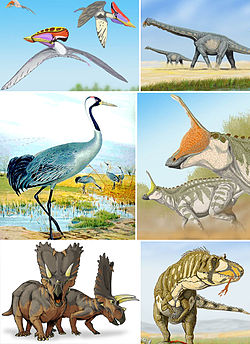Panaves
| Avemetatarsalians Temporal range: Middle Triassic–Present, 245–0 Ma (possible Early Triassic record) |
|
|---|---|
 |
|
| Clockwise from top-left: Tupuxuara leonardi (a pterosaur), Alamosaurus sanjuanensis, (a sauropod), Tsintaosaurus spinorhinus (an ornithopod), Daspletosaurus torosus (a tyrannosaur), Pentaceratops sternbergii (a ceratopsian), and Grus grus (an extant avian). |
|
| Scientific classification | |
| Kingdom: | Animalia |
| Phylum: | Chordata |
| Clade: | Sauropsida |
| Clade: | Archosauria |
| Clade: |
Avemetatarsalia Benton, 1999 |
| Subgroups | |
| Synonyms | |
|
|
Avemetatarsalia (meaning "bird metatarsals") is a clade name established by British palaeontologist Michael Benton in 1999 for all crown group archosaurs that are closer to birds than to crocodiles. It includes a similarly defined subgroup, Ornithodira. An alternate name is Pan-Aves, or "all birds", in reference to its definition containing all animals, living or extinct, which are more closely related to birds than to crocodiles.
Members of this group include the Dinosauromorpha, Pterosauromorpha, the genus Scleromochlus, and Aphanosauria. Dinosauromorpha contains more basal forms, including Lagerpeton and Marasuchus, as well as more derived forms, including dinosaurs; birds, according to most modern scientists, belong to the latter as members of the theropods. Pterosauromorpha contains Pterosauria, which as far as is known were the first vertebrates capable of true flight. Aphanosaurs are a recently recognized group of carnivorous quadrupedal bird-line archosaurs only known from the Triassic.
Bird-line archosaurs appear in the fossil record by the Anisian stage of the Middle Triassic about 245 million years ago, represented by the dinosauriform Asilisaurus. However, Early Triassic fossil footprints reported in 2010 from the Świętokrzyskie (Holy Cross) Mountains of Poland may belong to a more primitive dinosauromorph. If so, the origin of avemetatarsalians would be pushed back into the early Olenekian age, around 249 Ma. The oldest Polish footprints are classified in the ichnogenus Prorotodactylus and were made by an unknown small quadrupedal animal, but footprints called Sphingopus, found from Early Anisian strata, show that moderately large bipedal dinosauromorphs had appeared by 246 Ma. The tracks show that the dinosaur lineage appeared soon after the Permian–Triassic extinction event. Their age suggests that the rise of dinosaurs was slow and drawn out across much of the Triassic. The primitive traits found in the quadrupedal Teleocraters, shows that their last common ancestor had many crocodile-like features, and that the traits typical for the group evolved later.
...
Wikipedia
